-
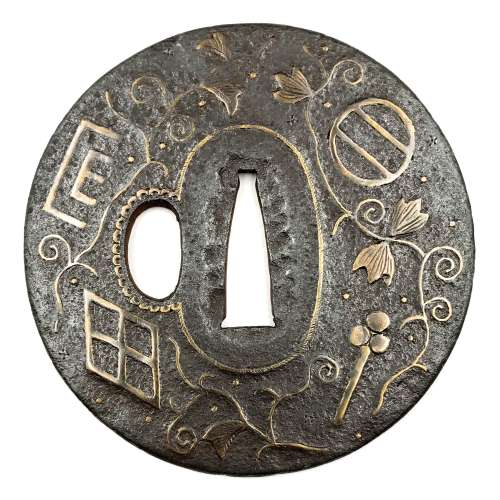 Thin iron tsuba of round form with design of family crests (mon) and arabesque (karakusa) in brass or copper inlay (suemon-zōgan) and occasional scattered brass dots or nail heads in ten-zōgan. Seppa-dai outlined with brass wire in the shape of a rope; kozuka-hitsu-ana outlined with scalloped brass wire. Rounded rim with iron bones (tekkotsu). The surface covered with lacquer (urushi). Ōnin school. Late Muromachi period, 16th century. Family crests on the face: 1:30: Two lines (double stripe) encircled (maruni futatsu biki). 4:30: Stylized clove (choji). 7:30: Divided rhombus, or four lozenges incorporated in one (wari-bishi); it is also called Takeda-bishi, the family crest of warrior Takeda Shingen (among the others). 10:00: Stylized Genji-mon (Genji kō-zu) or incense symbol. On the reverse: 2:00 - "Chinese cloud" not a crest. 5:00: Bit (Kutsuwa) 7:30: Number four in a fan (ōgi-san) 10:30: Two dots in a well frame (igeta).
Thin iron tsuba of round form with design of family crests (mon) and arabesque (karakusa) in brass or copper inlay (suemon-zōgan) and occasional scattered brass dots or nail heads in ten-zōgan. Seppa-dai outlined with brass wire in the shape of a rope; kozuka-hitsu-ana outlined with scalloped brass wire. Rounded rim with iron bones (tekkotsu). The surface covered with lacquer (urushi). Ōnin school. Late Muromachi period, 16th century. Family crests on the face: 1:30: Two lines (double stripe) encircled (maruni futatsu biki). 4:30: Stylized clove (choji). 7:30: Divided rhombus, or four lozenges incorporated in one (wari-bishi); it is also called Takeda-bishi, the family crest of warrior Takeda Shingen (among the others). 10:00: Stylized Genji-mon (Genji kō-zu) or incense symbol. On the reverse: 2:00 - "Chinese cloud" not a crest. 5:00: Bit (Kutsuwa) 7:30: Number four in a fan (ōgi-san) 10:30: Two dots in a well frame (igeta). -
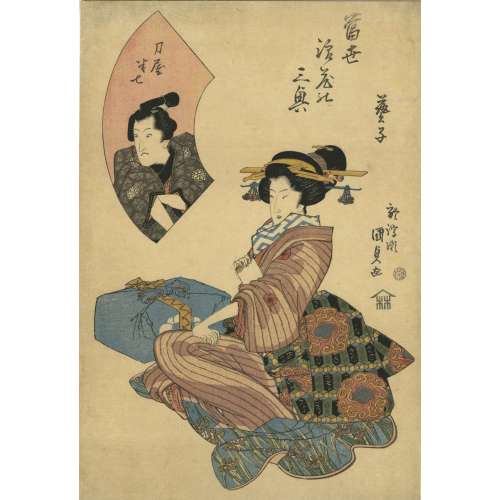 The right sheet of (optional) triptych: Geisha (Geiko) and kabuki actor Iwai Hanshirō V as Katanaya Hanshichi from Three pleasures of present-day Osaka (Tōsei Naniwa no sankō)「当世浪花の三興 芸子」 「刀屋半七」五代目岩井半四郎. Publisher: Iseya Rihei [伊勢屋利兵衛] (Japanese, fl. 1790s – c. 1879) Year: 1821 (Bunsei 4). Size: Vertical ōban; 36.5 x 25.2 cm. Signed: 於浮瀬亭国貞画 – Drawn by Kunisada in Ukabuse (Ukabuse ni oite Kunisada ga). Ukabuse is the name of a famous restaurant in Osaka, this signature can be found only on a three print bijin series [Kunisada Project]. Censor's seal: kiwame 改印:極 Actor Iwai Hanshirō V [岩井半四郎] (Japanese, 1776 – 1847); other names: Iwai Tojaku, Iwai Kumesaburō I. Character: Katanaya Hanshichi [刀屋半七] Ref: MFA ACCESSION NUMBER 11.21938; LIB-2967.2022 Izzard. Full series (triptych) Three Pleasures of Present-day Osaka (Tōsei Naniwa no sankō):
The right sheet of (optional) triptych: Geisha (Geiko) and kabuki actor Iwai Hanshirō V as Katanaya Hanshichi from Three pleasures of present-day Osaka (Tōsei Naniwa no sankō)「当世浪花の三興 芸子」 「刀屋半七」五代目岩井半四郎. Publisher: Iseya Rihei [伊勢屋利兵衛] (Japanese, fl. 1790s – c. 1879) Year: 1821 (Bunsei 4). Size: Vertical ōban; 36.5 x 25.2 cm. Signed: 於浮瀬亭国貞画 – Drawn by Kunisada in Ukabuse (Ukabuse ni oite Kunisada ga). Ukabuse is the name of a famous restaurant in Osaka, this signature can be found only on a three print bijin series [Kunisada Project]. Censor's seal: kiwame 改印:極 Actor Iwai Hanshirō V [岩井半四郎] (Japanese, 1776 – 1847); other names: Iwai Tojaku, Iwai Kumesaburō I. Character: Katanaya Hanshichi [刀屋半七] Ref: MFA ACCESSION NUMBER 11.21938; LIB-2967.2022 Izzard. Full series (triptych) Three Pleasures of Present-day Osaka (Tōsei Naniwa no sankō):


-
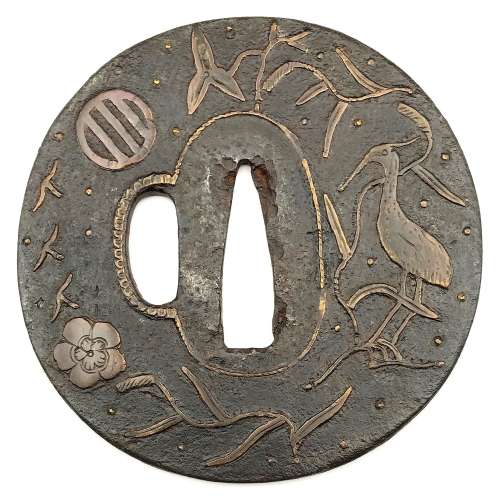 Iron tsuba of round form profusely decorated with brass inlay of plants, birds, well, and family crests (mon) in suemon-zōgan technique and occasional brass dots (nail-heads) or ten-zōgan. Seppa-dai and kozuka-hitsu-ana outlined with brass inaly, possibly repaired: rope-shaped wire here and there replaced with flat wire. The plate is very thin, with remnants of lacquer. Ōnin school. Size: 75.8 x 75.2 x 2.3 mm. Weight: 77.5 g. On the front side (omote) motif includes the following elements (from 12 o'clock, clockwise):
Iron tsuba of round form profusely decorated with brass inlay of plants, birds, well, and family crests (mon) in suemon-zōgan technique and occasional brass dots (nail-heads) or ten-zōgan. Seppa-dai and kozuka-hitsu-ana outlined with brass inaly, possibly repaired: rope-shaped wire here and there replaced with flat wire. The plate is very thin, with remnants of lacquer. Ōnin school. Size: 75.8 x 75.2 x 2.3 mm. Weight: 77.5 g. On the front side (omote) motif includes the following elements (from 12 o'clock, clockwise):- Water plantain (a.k.a. arrowhead, or omodaka): "a perpetual plant of the water plantain family, was also called shōgunsō (victorious army grass). Because of this martial connotation, it was a design favored for the crests of samurai families" [see: Family Crests of Japan. // Stone Bridge Press, Berkeley, CA, 2007; p. 63].
- Heron (sagi): "...considered an emblem of longevity, and from China comes the practice of regarding the bird as a mount of the gods and the Taoist sennin. [...] heron also reflects an inauspicious connotation, for the word sagi is homophone for 'fraud' and 'false pretenses'." [see: Merrily Baird. Symbols of Japan. Thematic motifs in art and design. // Rizzoli international publications, Inc., 2001; p. 112]. Some may say, that this is not a heron but a crane (tsuru). It's very possible, and in this case the negative connotation is lost, but the reference to longevity and allusion to sennin remain.
- Pampas grass (susuki, or obana): as per Merrily Baird, p. 95 and John W. Dower, p. 66, pampas grass is one of the Seven Grasses of Autumn. When combined with flying wild gees, conveys strong autumnal mood.
- Plum blossom (ume): according to Merrily Baird, the flower has a vast variety of symbolic meanings, including longevity, and a reference to the Chinese Taoists. It is used in 80 family crests [see: Japanese Design Motifs: 4,260 Illustrations of Japanese Crests; Compiled by the Matsuya Piece-Goods Store; Translated by Fumie Adachi. // Dover Publications, Inc., 1972.] Plum is "celebrated for its sweet perfume, delicate blossoms, and habit of blooming at the end of winter".
- Tree flying wild geese (kari): "Wild geese arrive in large flocks in southern regions during the autumn months, and following their migratory instincts, head back north in spring" [Family Crests of Japan, pp. 85-86]. "The importance of geese in Japanese art was further secured by stories of several military heroes who had achieved victory in battle when a sudden breaking of ranks by flying geese signaled an ambush. The protective role of the birds led to their frequent use in decorating sword furnishings and possibly also their adoption as a family crest motif.Finally, the goose in Asia plays a role in religious traditions" [Merrily Baird, pp.111-112].
- Hikiryō (line, or bar, or stripe) - a symbol which consists of one, two, or three horizontal or vertical stripes in a circle. "In wartime, Japanese generals [...] surrounded their encampments with huge cloth curtains. Usually these were made of cloth sewn together horizontally and varying in color [...] to distinguish the individual general and his followers. The stripe thus assumed strong martial connotations, and became a mark of identification on personal military gear as well. In the early fourteenth century the heads of the Ashikaga and Nitta, then the two most powerful clans in Japan, both adopted stripe patterns as a family crest". [See: Family Crests of Japan, p. 111 and John W. Dower. The elements of Japanese design - A handbook of family crests, heraldry & symbolism. // Weatherhill, New York, Tokyo, 1985, p. 144].
- Hikiryō, see above.
- Pampas grass (susuki, or obana), see above.
- Bellflower (kikyo): One of the Seven Grasses of Autumn. "As a crest, it have been adopted among the warriors around the thirteenth century, primarily because of it's beauty" [John W. Dower, p. 48].
- Four flying wild geese (kari), see above.
- Weeping willow (yanagi): "It is commonly represented with water, snow, swallows, or herons. A branch of willow (yoshi) is one of the attributes of the Buddhist deity Senju Kannon (Thousand-Armed Kannon), who is said to use the branch to sprinkle the nectar of life contained in a vase. [Merrily Baird, pp. 66-67].
- Lone plum blossom in a well frame/crib (igeta, izitsu): "Well crib was one of the most popular motifs in Japanese heraldry". As a crest it may stay simply for the first character (i) of the family name, however, with a flower inside the well frame, and together with the other symbols present, it may aggravate the sense of autumn-ness. The ten-zōgan dots in this particular case may represent the snowflakes or autumn stars.
-
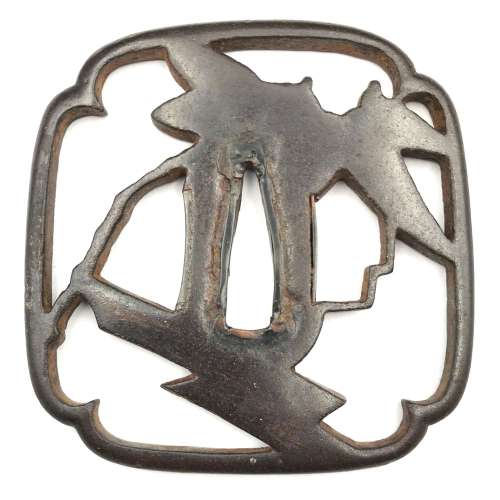 Iron tsuba of quatrefoil form with design of bamboo stems and leaves, and a plank bridge in openwork (sukashi). Hitsu-ana of irregular form. Iron with smooth chocolate patina. Copper and shakudō sekigane. This piece is illustrated in Sasano: Japanese Sword Guard Masterpieces from the Sasano Collection, 1994 on page 295 under № 254 with the following description:
Iron tsuba of quatrefoil form with design of bamboo stems and leaves, and a plank bridge in openwork (sukashi). Hitsu-ana of irregular form. Iron with smooth chocolate patina. Copper and shakudō sekigane. This piece is illustrated in Sasano: Japanese Sword Guard Masterpieces from the Sasano Collection, 1994 on page 295 under № 254 with the following description:Nishigaki. First generation Kanshiro (died in the sixth year of Genroku, 1693, at the age of 81). Sukashi design: Bamboo (take). Early Edo period, late 17th century (Kanbun / Enppo era). Height: 72.6 mm; Width: 71.5 mm; Rim thickness: .6 mm; Centre thickness: 5.1 mm. Rounded rim. The shape of this sword guard is a quatrefoil and the design is arranged in the form of a saddle flap. Two bamboo trunks with leaves comprise the design. Calm, soothing and sophisticated are the features of this artist in his later years. Such characteristics may remind one of the work of the first Hikozo.
Provenance: Sasano Masayuki collection, № 254. What is interesting, and what had been found by Bruce Kirkpatrick, is that in the earlier photograph of the same piece ['Sukashi tsuba - bushido no bi' by Sasano Masayuki, photography by Fujimoto Shihara, 1972 (in Japanese), page 245, №201] we clearly see kebori - linear carving that decorates the bamboo leaves and the planks of the bridge. The said kebori have totally disappeared between 1972 and 1994. The tsuba became absolutely flat! Now we can only speculate about the reasons for such cruel treatment of the artistically and historically important item.
Sukashi tsuba - bushido no bi. Author: Sasano Masayuki, photography: Fujimoto Shihara, 1972 (in Japanese). Page 245, №201.
-
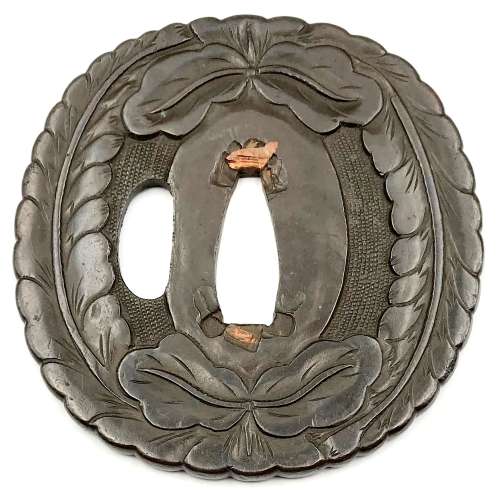 A yamagane (unrefined copper) ko-kinko tsuba of slightly elongated round form with design of wisteria carved in sculptural relief (nikubori). Copper sekigane. Unsigned. Muromachi period, likely the 16th century.
A yamagane (unrefined copper) ko-kinko tsuba of slightly elongated round form with design of wisteria carved in sculptural relief (nikubori). Copper sekigane. Unsigned. Muromachi period, likely the 16th century.Size: 74.3 x 71.8 x 3.2 mm.
NBTHK certificate №4003986: Hozon (worthy preservation). In custom wooden box. -
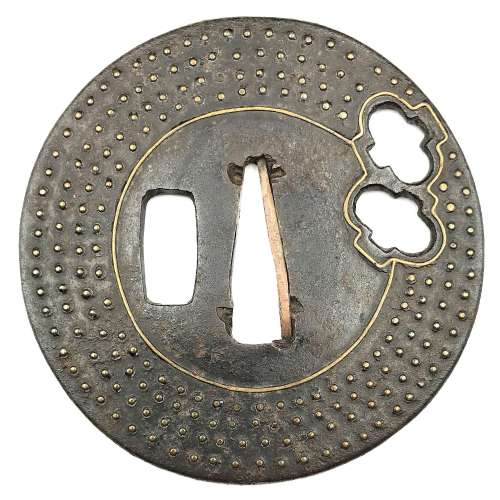 Iron tsuba of round form with design of two paper lanterns in openwork (small cut-outs, ko-sukashi ) outlined with brass wire. The plate is decorated with four concentric rows of brass dot inlay (ten-zōgan), with a brass circular wire inside the innermost row of dots (missing on the back). Hitsu-ana of rectangular form is not outlined with brass wire, which let us suppose that it was cut out at a later date. Copper sekigane. Mid Muromachi period (1454-1513). Diameter: 74.0 mm, thickness: 2.6 mm. Tsuba is illustrated at: 新版 日本刀講座 小道具鑑定編 本間 薫山 佐藤 寒山 : Shinhan Nihonto Koza, Volume VI, Kodogu Part 1. Under supervision of Honma Kunzan and Sato Kanzan. 鍔 無名 応仁 鉄地) 丸形 小透 槌目 真鍮据文 点象嵌 丸耳 : Tsuba with no signature, Ōnin style. Base metal iron (jigane), round shape, small perforations (ko-sukashi), hammering finish (tsuchime). Pre-cast brass inlay (shinchu suemon-zōgan); dot inlay (ten-zōgan); round edge (maru-mimi).
Iron tsuba of round form with design of two paper lanterns in openwork (small cut-outs, ko-sukashi ) outlined with brass wire. The plate is decorated with four concentric rows of brass dot inlay (ten-zōgan), with a brass circular wire inside the innermost row of dots (missing on the back). Hitsu-ana of rectangular form is not outlined with brass wire, which let us suppose that it was cut out at a later date. Copper sekigane. Mid Muromachi period (1454-1513). Diameter: 74.0 mm, thickness: 2.6 mm. Tsuba is illustrated at: 新版 日本刀講座 小道具鑑定編 本間 薫山 佐藤 寒山 : Shinhan Nihonto Koza, Volume VI, Kodogu Part 1. Under supervision of Honma Kunzan and Sato Kanzan. 鍔 無名 応仁 鉄地) 丸形 小透 槌目 真鍮据文 点象嵌 丸耳 : Tsuba with no signature, Ōnin style. Base metal iron (jigane), round shape, small perforations (ko-sukashi), hammering finish (tsuchime). Pre-cast brass inlay (shinchu suemon-zōgan); dot inlay (ten-zōgan); round edge (maru-mimi).
 English translation of the book indicated above Nihon Tō Kōza, Volume VI, Part 1 by Harry Afu Watson, AFU Research Enterprises, Inc., 1993. Tsuba in question illustrated on page 14 and described as follows: " Tsuba mumei Ōnin. Tetsu ji maru gata ko-sukashi tsuchime shitate shinchū suemon ten zogan maru mimi. Brass suemon". My question remains: why such a text is called 'translation' while it looks more like transliteration of romanization?
English translation of the book indicated above Nihon Tō Kōza, Volume VI, Part 1 by Harry Afu Watson, AFU Research Enterprises, Inc., 1993. Tsuba in question illustrated on page 14 and described as follows: " Tsuba mumei Ōnin. Tetsu ji maru gata ko-sukashi tsuchime shitate shinchū suemon ten zogan maru mimi. Brass suemon". My question remains: why such a text is called 'translation' while it looks more like transliteration of romanization? -
 Title page: УТОПИЧЕСКИЙ РОМАН XVI – XVII ВЕКОВ | ТОМАС МОР | УТОПИЯ |•| КАМПАНЕЛЛА | ГОРОД СОЛНЦА |•| ФРЭНСИС БЭКОН | НОВАЯ АТЛАНТИДА |•| СИРАНО ДЕ БЕРЖЕРАК | ГОСУДАРСТВА ЛУНЫ |•| ДЕНИ ВЕРАС | ИСТОРИЯ СЕВАРАМБОВ | {PUBLISHER’S DEVICE} | ИЗДАТЕЛЬСТВО | «ХУДОЖЕСТВЕННАЯ ЛИТЕРАТУРА» | МОСКВА • 1971 || Pagination: [1-4] 5-493 [494] [2], 10 plates extraneous to collation. Collation: 16mo; [1]16 2-1516 168. Binding: 20.5 x 15 cm, burgundy cloth, gilt serial device to cover, gilt lettering to spine, pictorial DJ. Colophon: БИБЛИОТЕКА ВСЕМИРНОЙ ЛИТЕРАТУРЫ | СЕРИЯ ПЕРВАЯ | Том 34 || Print run 300,000 copies
Title page: УТОПИЧЕСКИЙ РОМАН XVI – XVII ВЕКОВ | ТОМАС МОР | УТОПИЯ |•| КАМПАНЕЛЛА | ГОРОД СОЛНЦА |•| ФРЭНСИС БЭКОН | НОВАЯ АТЛАНТИДА |•| СИРАНО ДЕ БЕРЖЕРАК | ГОСУДАРСТВА ЛУНЫ |•| ДЕНИ ВЕРАС | ИСТОРИЯ СЕВАРАМБОВ | {PUBLISHER’S DEVICE} | ИЗДАТЕЛЬСТВО | «ХУДОЖЕСТВЕННАЯ ЛИТЕРАТУРА» | МОСКВА • 1971 || Pagination: [1-4] 5-493 [494] [2], 10 plates extraneous to collation. Collation: 16mo; [1]16 2-1516 168. Binding: 20.5 x 15 cm, burgundy cloth, gilt serial device to cover, gilt lettering to spine, pictorial DJ. Colophon: БИБЛИОТЕКА ВСЕМИРНОЙ ЛИТЕРАТУРЫ | СЕРИЯ ПЕРВАЯ | Том 34 || Print run 300,000 copiesВступительная статья: Л. Воробьев
Томас Мор: Утопия. Перевод А. Малеина и Ф. Петровского.
Томмазо Кампанелла: Город Солнца. Перевод Ф. Петровского.
Фрэнсис Бэкон: Новая Атлантида. Перевод З. Александровой.
Сирано де Бержерак: Государства Луны. Перевод Е. Гунста.
Дени Верас: История Севарамбов. Перевод Е. Дмитриевой.
Примечания А. Малеина, Ф. Петровского, Ф. Коган-Бернштейн, Ф. Шуваевой.
Художник: Селиверстов, Юрий Иванович (Russian, b. 1940) Authors, translators:More, Sir Thomas (British, 1478 –1535)
Campanella, Tommaso (Italian, 1568 – 1639) Bacon, Francis (British, 1561 –1626) Cyrano de Bergerac, Savinien de (French, 1619 – 1655) Vairasse d' Allais, Denis (French, c. 1630 – 1672) Малеин, Александр Иустинович (Russian, 1869 – 1938) Петровский, Фёдор Александрович (Russian, 1890 – 1978) Елизавета Ивановна Дмитриева [Васильева; Черубина де Габриак] (Russian, 1887 – 1928) Александрова, Зинаида Николаевна (Russian, 1907—1983) Гунст, Евгений Анатольевич (Russian, 1901 – 1983) Коган-Бернштейн, Фаина Абрамовна [Аронгауз] (Russian, 1899 – 1976) -
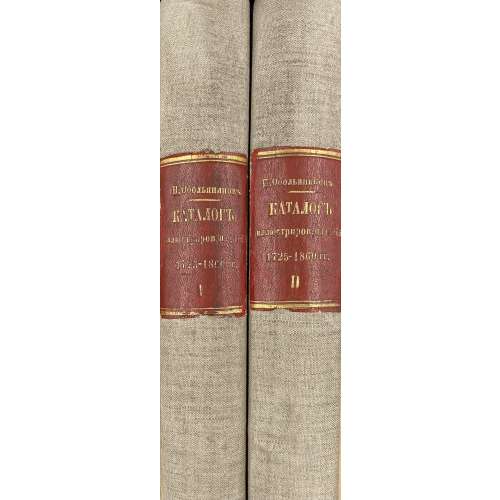 Two volumes, 32 x 24 cm each, uniformly bound in grey cloth with crimson morocco labels with gilt lettering to spine “Н. Обольяниновъ | КАТАЛОГЪ | иллюстриров. изданiй | 1725-1860 гг. | I (II)”, original wrappers preserved. To t.p. verso ink stamps “Latvijas PSR Zinātn̦u akadēmija Fundamentālā bibliotēka”, “1964”, “KATALOGS”, and “Z.A.B. Inv. № 80274”. Printed on laid paper, pagination throughout. 3,038 items with bibliographical descriptions. Title-page: КАТАЛОГЪ | РУССКИХЪ ИЛЛЮСТРИРОВАННЫХЪ | ИЗДАНIЙ | 1725—1860 гг. | — | СОСТАВИЛЪ | Н. Обольяниновъ. | Въ двухъ томахъ | Т. I (II). | ~ | МОСКВА – 1914 (1915). | Товарищество ТИПОГРАФIИ А. И. МАМОНТОВА, | Арбатская пл., Филипповский пер., д. № 11. || Vol. I: Collation: π6 1-424, total 174 leaves; pp.: [i-v] vi-xii, [1] 2-335 [336 errata] (total 348 pages); within green publisher’s wrappers. Vol. II: π2 1-444, total 178 leaves; pp.: [4] [337] 338-686 [687 errata], [688 blank] (total 356 pages); within green publisher’s wrappers. Provenance: Fundamental library of the Latvian Academy of Sciences. Contributors: Николай Александрович Обольянинов (Russian, 1868 – 1916) – author. Анатолий Иванович Ма́монтов (Russian, 1839 – 1905) – publisher.
Two volumes, 32 x 24 cm each, uniformly bound in grey cloth with crimson morocco labels with gilt lettering to spine “Н. Обольяниновъ | КАТАЛОГЪ | иллюстриров. изданiй | 1725-1860 гг. | I (II)”, original wrappers preserved. To t.p. verso ink stamps “Latvijas PSR Zinātn̦u akadēmija Fundamentālā bibliotēka”, “1964”, “KATALOGS”, and “Z.A.B. Inv. № 80274”. Printed on laid paper, pagination throughout. 3,038 items with bibliographical descriptions. Title-page: КАТАЛОГЪ | РУССКИХЪ ИЛЛЮСТРИРОВАННЫХЪ | ИЗДАНIЙ | 1725—1860 гг. | — | СОСТАВИЛЪ | Н. Обольяниновъ. | Въ двухъ томахъ | Т. I (II). | ~ | МОСКВА – 1914 (1915). | Товарищество ТИПОГРАФIИ А. И. МАМОНТОВА, | Арбатская пл., Филипповский пер., д. № 11. || Vol. I: Collation: π6 1-424, total 174 leaves; pp.: [i-v] vi-xii, [1] 2-335 [336 errata] (total 348 pages); within green publisher’s wrappers. Vol. II: π2 1-444, total 178 leaves; pp.: [4] [337] 338-686 [687 errata], [688 blank] (total 356 pages); within green publisher’s wrappers. Provenance: Fundamental library of the Latvian Academy of Sciences. Contributors: Николай Александрович Обольянинов (Russian, 1868 – 1916) – author. Анатолий Иванович Ма́монтов (Russian, 1839 – 1905) – publisher. -
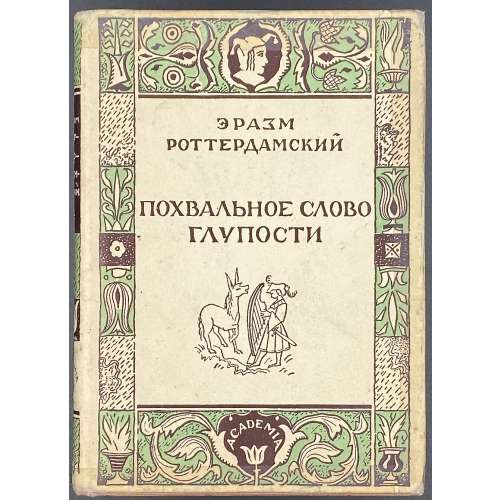
Title page [in black and blue]: ЭРАЗМ | РОТТЕРДАМСКИЙ | ПОХВАЛЬНОЕ СЛОВО | ГЛУПОСТИ | ПЕРЕВОД И КОММЕНТАРИИ | П. К. ГУБЕРА | ВСТУПИТЕЛЬНАЯ СТАТЬЯ | И. СМИЛГИ | {vignette} | ACADEMIA | МОСКВА ~ ЛЕНИНГРАД | 1932 ||
Pagination: [1-7] 8-236 [4], in-text illustrations after Hans Holbein the Younger, title page, DJ, cloth by Л. С. Хижинский, photo reproduction of the portrait of Erasmus by Hans Holbein the Younger from The Louvre museum w/guard paper.
Collation: 8vo; [1]8 2-158, + 1 plate extraneous to collation (portrait).
Binding: 18 x 13 cm; Pictorial stamped cloth, pictorial DJ, pictorial endpapers, back board blind-stamped.
Print run: 5,300 copies.
Catalogue raisonné: Крылов-Кичатова (2004), №477, p. 221. (in 1930 section). Contributors: Desiderius Erasmus Roterodamus (Dutch, c. 1469 – 1536) – author of the original text in Latin. Hans Holbein the Younger (German, 1497/8 – 1543) – artist. Губер, Пётр Константинович (Russian, 1886 – 1941) – translator from Latin into Russian (died in GULAG) Смилга, Ивар Тенисович (Latvian-Russian, 1892 – 1937) – author, foreword (shot by a firing squad). Хижинский, Леонид Семёнович (Russian, 1896 – 1972) – artist (title page, DJ, cloth). -
 Title (black and red): ДЖЕЙМС МАКФЕРСОН | ПОЭМЫ ОССИАНА | {device} | ИЗДАНИЕ ПОДГОТОВИЛ | Ю. Д. ЛЕВИН | ИЗДАТЕЛЬСТВО «НАУКА» | ЛЕНИНГРАДСКОЕ ОТДЕЛЕНИЕ | ЛЕНИНГРАД | 1983 || Title verso: РЕДАКЦИОННАЯ КОЛЛЕГИЯ СЕРИИ | «ЛИТЕРАТУРНЫЕ ПАМЯТНИКИ» | (list of names) | Ответственный редактор | академик М. П. АЛЕКСЕЕВ (in frame) | Редактор перевода | Э. Л. ЛИНЕЦКАЯ. Frontispiece (black and red): JAMES MACPHERSON | THE POEMS OF OSSIAN | {device} || Print run: 30,000 copies. Collation: 8vo; [1]8 2-378. Pagination: [1, 2] – serial h.t. / frontis.] [3, 4] – t.p. / editorial board] [portrait / blank] [5, 6] – original t.p. fac-simile / text, 7–589 [590] – imprint, [2] – advert.; 3 leaves of plates. Binding: serial green buckram blind-stamped with a scroll adorned with gold lettering to board and spine. Джеймс Макферсон. Поэмы Оссиана. Ю. Д. Левин. Э. Л. Линецкая.
Title (black and red): ДЖЕЙМС МАКФЕРСОН | ПОЭМЫ ОССИАНА | {device} | ИЗДАНИЕ ПОДГОТОВИЛ | Ю. Д. ЛЕВИН | ИЗДАТЕЛЬСТВО «НАУКА» | ЛЕНИНГРАДСКОЕ ОТДЕЛЕНИЕ | ЛЕНИНГРАД | 1983 || Title verso: РЕДАКЦИОННАЯ КОЛЛЕГИЯ СЕРИИ | «ЛИТЕРАТУРНЫЕ ПАМЯТНИКИ» | (list of names) | Ответственный редактор | академик М. П. АЛЕКСЕЕВ (in frame) | Редактор перевода | Э. Л. ЛИНЕЦКАЯ. Frontispiece (black and red): JAMES MACPHERSON | THE POEMS OF OSSIAN | {device} || Print run: 30,000 copies. Collation: 8vo; [1]8 2-378. Pagination: [1, 2] – serial h.t. / frontis.] [3, 4] – t.p. / editorial board] [portrait / blank] [5, 6] – original t.p. fac-simile / text, 7–589 [590] – imprint, [2] – advert.; 3 leaves of plates. Binding: serial green buckram blind-stamped with a scroll adorned with gold lettering to board and spine. Джеймс Макферсон. Поэмы Оссиана. Ю. Д. Левин. Э. Л. Линецкая. -
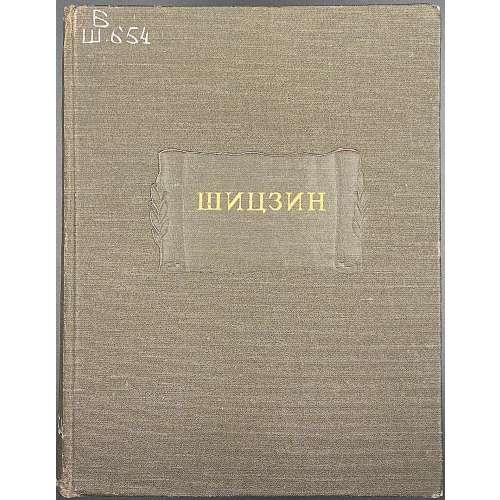 Title (black and red): ШИЦЗИН | [device} | ИЗДАНИЕ ПОДГОТОВИЛИ | А.А. ШТУКИН И Н.Т. ФЕДОРЕНКО | ИЗДАТЕЛЬСТВО АКАДЕМИИ НАУК СССР | МОСКВА | 1957 Title page verso: РЕДАКЦИОННАЯ КОЛЛЕГИЯ СЕРИИ «ЛИТЕРАТУРНЫЕ ПАМЯТНИКИ» (names) Ответственный редактор доктор филологических наук Н. Т. ФЕДОРЕНКО Поэтическая редакция А. Е. АДАЛИС Pagination: [1, 2] – serial h.t / title in Chinese 诗经, [3, 4] – t.p. / editorial board, [5, 6] – editorial / blank, [7, 8] – f.t. / blank, 9-610 [611] [612 colophon]; print run 3,500 copies. Collation: [1]8 2-398. Binding: 23 x 17.5 cm; serial green cloth blind-stamped with a scroll adorned with gold lettering to board and spine. Содержание: От редакции. — С. 5; Шицзин / Пер. A.A. Штукина: Нравы царств. — С. 7-193; Малые оды. — С. 195-325; Великие оды. — С. 327-409; Гимны. — С. 411-466. Приложения: Федоренко Н.Т. «Книга песен». — С. 469-530; Комментарии / Сост. A.A. Штукин, ред. В.А. Кривцов. — С. 531-600.
Title (black and red): ШИЦЗИН | [device} | ИЗДАНИЕ ПОДГОТОВИЛИ | А.А. ШТУКИН И Н.Т. ФЕДОРЕНКО | ИЗДАТЕЛЬСТВО АКАДЕМИИ НАУК СССР | МОСКВА | 1957 Title page verso: РЕДАКЦИОННАЯ КОЛЛЕГИЯ СЕРИИ «ЛИТЕРАТУРНЫЕ ПАМЯТНИКИ» (names) Ответственный редактор доктор филологических наук Н. Т. ФЕДОРЕНКО Поэтическая редакция А. Е. АДАЛИС Pagination: [1, 2] – serial h.t / title in Chinese 诗经, [3, 4] – t.p. / editorial board, [5, 6] – editorial / blank, [7, 8] – f.t. / blank, 9-610 [611] [612 colophon]; print run 3,500 copies. Collation: [1]8 2-398. Binding: 23 x 17.5 cm; serial green cloth blind-stamped with a scroll adorned with gold lettering to board and spine. Содержание: От редакции. — С. 5; Шицзин / Пер. A.A. Штукина: Нравы царств. — С. 7-193; Малые оды. — С. 195-325; Великие оды. — С. 327-409; Гимны. — С. 411-466. Приложения: Федоренко Н.Т. «Книга песен». — С. 469-530; Комментарии / Сост. A.A. Штукин, ред. В.А. Кривцов. — С. 531-600.(Shijing)
-
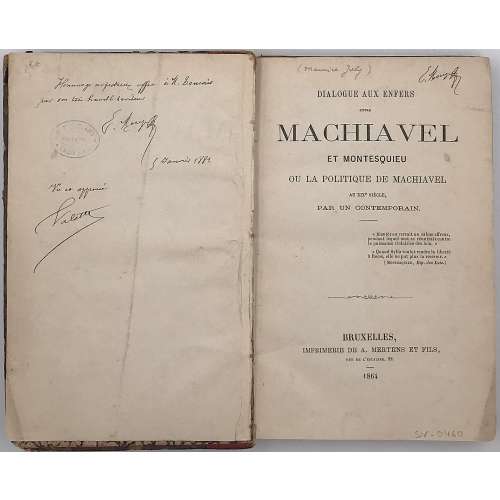 Title page: DIALOGUE AUX ENFERS | ENTRE | MACHIAVEL | ET MONTESQUIEU | OU LA POLITIQUE DE MACHIAVEL | AU XIXe SIÈCLE, | PAR UN CONTEMPORAIN. | {6 lines of citations} | ~ | BRUXELLES, | IMPRIMERIE DE A. MERTENS ET FILS, | RUE DE L’ESCALIER, 22. | 1864 ||
Title page: DIALOGUE AUX ENFERS | ENTRE | MACHIAVEL | ET MONTESQUIEU | OU LA POLITIQUE DE MACHIAVEL | AU XIXe SIÈCLE, | PAR UN CONTEMPORAIN. | {6 lines of citations} | ~ | BRUXELLES, | IMPRIMERIE DE A. MERTENS ET FILS, | RUE DE L’ESCALIER, 22. | 1864 ||Description: 17.9 x 12 cm, quarter red morocco over marbled boards, spine with raised bands, gilt bees in compartments, gilt lettering, marbled endpapers, ffep cut out top 1/4, ffep and h.t. loose.
Collation: 12mo; fep, π4 1-2712, 292, fep.; total 174 leaves. Pagination: [2 h.t] [2 t.p.] [i] ii-iii [iv] [1] 2-337 [338] [2 errata].Inscriptions and markings: "Hommage respectueux offert à M. Bourdais par son très humble serviteur, 5 Janvier 1881". Signature: E. Rouger (?) "Vu et approuvé". "Valatte". Ink stamp: "M<aîtr>e E. Brouard - Notaire a Laon Aisne".
Other copies: LIB-1034.2016 and LIB-2913.2021. Other related objects: SVVP-0062.2021. The publication was funded by the author and smuggled into France. Contributors: Maurice Joly (French, 1829 – 1878) -
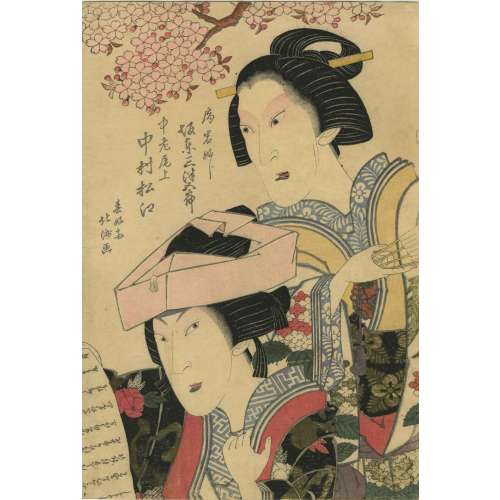 Bando Mitsugorō III as Lady Iwafuji and Nakamura Matsue III as Lady Onoe, 1821.「局岩ふじ 坂東三津五郎」(三代)、「中老尾上 中村松江」(三代) in kabuki play Kagamiyama Kokyô no Nishikie [鏡山旧錦繪] (Mirror mountain: A women’s treasury of loyalty); author: Yô Yôdai. Artist: Shunkōsai Hokushū (春好斎 北洲), who is also known as Shunkō IV, active from about 1802 to 1832. Actors: Bandō Mitsugorō III [三代目 坂東 三津五郎] (Japanese, 1775 – 1831); other names: Bandō Minosuke I, Morita Kanjirô II, Bandō Mitahachi I, Bandō Minosuke I, Bandō Mitahachi I. Nakamura Matsue III [三代目中村松江] (Japanese, 1786-1855); other names: Nakamura Sankō I, Nakamura Tomijūrō II, Ichikawa Kumatarō. Year: 1821 (Bunsei 4), 1st month. Publisher: Wataya Kihei (Wataki) (Japanese, fl. c. 1809 – 1885) Signed Shunkôsai Hokushû ga 春好斎北洲画. MFA Accession № 11.35375. MFA description: "Play: Keisei Kagamiyama (Mirror Mountain, a Courtesan Play). Theatre: Kado けいせい双鏡山(けいせいかがみやま)角. Ref.: [LIB-1193.2013] Leiter. Kabuki Encyclopedia, p. 156; [LIB-0879-2.2015] Kabuki plays on stage (vol. 2): 1773-1799, pp. 172-212.
Bando Mitsugorō III as Lady Iwafuji and Nakamura Matsue III as Lady Onoe, 1821.「局岩ふじ 坂東三津五郎」(三代)、「中老尾上 中村松江」(三代) in kabuki play Kagamiyama Kokyô no Nishikie [鏡山旧錦繪] (Mirror mountain: A women’s treasury of loyalty); author: Yô Yôdai. Artist: Shunkōsai Hokushū (春好斎 北洲), who is also known as Shunkō IV, active from about 1802 to 1832. Actors: Bandō Mitsugorō III [三代目 坂東 三津五郎] (Japanese, 1775 – 1831); other names: Bandō Minosuke I, Morita Kanjirô II, Bandō Mitahachi I, Bandō Minosuke I, Bandō Mitahachi I. Nakamura Matsue III [三代目中村松江] (Japanese, 1786-1855); other names: Nakamura Sankō I, Nakamura Tomijūrō II, Ichikawa Kumatarō. Year: 1821 (Bunsei 4), 1st month. Publisher: Wataya Kihei (Wataki) (Japanese, fl. c. 1809 – 1885) Signed Shunkôsai Hokushû ga 春好斎北洲画. MFA Accession № 11.35375. MFA description: "Play: Keisei Kagamiyama (Mirror Mountain, a Courtesan Play). Theatre: Kado けいせい双鏡山(けいせいかがみやま)角. Ref.: [LIB-1193.2013] Leiter. Kabuki Encyclopedia, p. 156; [LIB-0879-2.2015] Kabuki plays on stage (vol. 2): 1773-1799, pp. 172-212. -
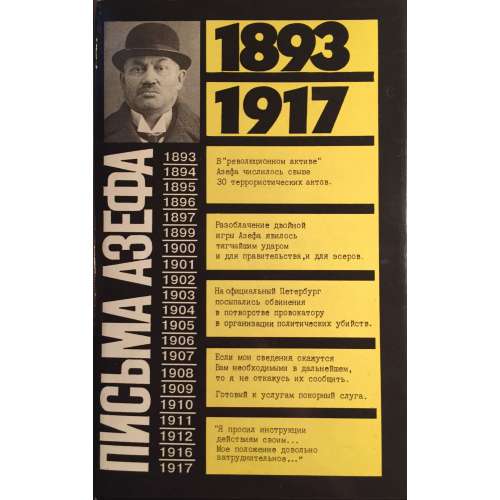 Hardcover volume 20.7 x 13.4 cm, bound in black buckram with blind and grey lettering to front and grey lettering to spine, in a pictorial dust jacket, yellow pictorial endpapers, pp.: [2] 3-287 [1], collated in 16mo, 1-916, 144 leaves, 288 pages. Title-page: ПИСЬМА АЗЕФА | — | 1893 – 1917 | — | [blank] | {publisher’s device} | МОСКВА | «ТЕРРА» — «TERRA» | 1994 || Print run: 10,000 copies. Азеф, Евгений Филиппович [Евно Фишелевич], [Azef, Yevno] (Jewish-Russian-German, 1869 – 1918) Павлов, Дмитрий Борисович (Russian, b. 1954) Перегудова, Зинаида Ивановна (Russian, b. 1934)
Hardcover volume 20.7 x 13.4 cm, bound in black buckram with blind and grey lettering to front and grey lettering to spine, in a pictorial dust jacket, yellow pictorial endpapers, pp.: [2] 3-287 [1], collated in 16mo, 1-916, 144 leaves, 288 pages. Title-page: ПИСЬМА АЗЕФА | — | 1893 – 1917 | — | [blank] | {publisher’s device} | МОСКВА | «ТЕРРА» — «TERRA» | 1994 || Print run: 10,000 copies. Азеф, Евгений Филиппович [Евно Фишелевич], [Azef, Yevno] (Jewish-Russian-German, 1869 – 1918) Павлов, Дмитрий Борисович (Russian, b. 1954) Перегудова, Зинаида Ивановна (Russian, b. 1934)ISBN: 5-85255-395-6. Azef Letters (Rus).
-
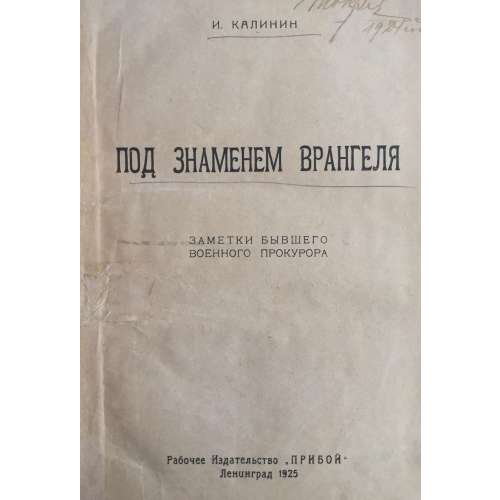
И. М. Калинин. Под знаменем Врангеля. Заметки бывшего военного прокурора. - Л.: Рабочее из-во "Прибой", 1925. - 273 с.
Тираж 7125 экз.
Об авторе: «К моменту февральской революции я занимал должность помощника военного прокурора Кавказского военно-окружного суда... Я не был политиком, но не переносил Союза русского народа. Падение монархии приветствовал. В 1917 году в г. Эрзеруме, занимая довольно приличный пост, работал в самом тесном содружестве с Советом солдатских и рабочих депутатов. Меньшевики, эсэры, большевики постоянно навещали меня, зная, что я хотя и внепартийный, но искренно предан делу революции». В 1918-м Калинину удалось перебраться в занятый Добровольческой армией Екатеринодар, откуда в конце сентября 1918 г. он выехал на Дон. «Здесь тоже мобилизовали всех офицеров. Мне ничего другого не оставалось, как поступить на службу в только что сорганизованный Донской военно-окружной суд». Будучи профессиональным военным юристом Калинин в дальнейшем состоял прокурором при временном Донском военном суде.
По возвращении из эмиграции полковник Калинин, как и многие другие репатрианты, пытался избавиться от клейма «бывшего белогвардейца». 5 октября 1937 г. И. М. Калинин, в то время преподаватель рабочего факультета Ленинградского автодорожного института, был арестован по решению Комиссии НКВД и Прокуратуры СССР . 2 ноября 1937 г. он был приговорен по ст. 58-6-8-11 УК РСФСР к высшей мере наказания и расстрелян в Ленинграде 10 ноября 1937 года.
-
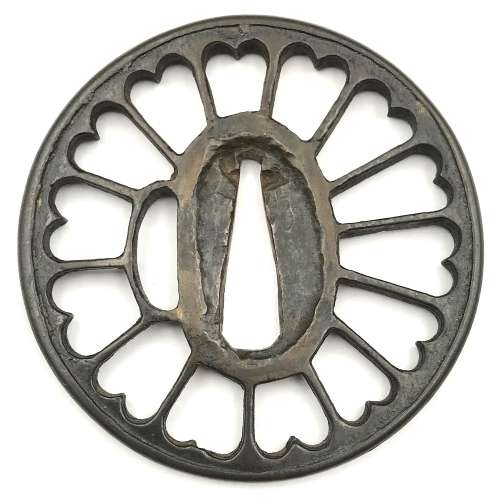 Yamagane tsuba of round form with design of a 14 petal chrysanthemum (kiku) in cast openwork (sukashi), with slightly raised rounded rim. Early Muromachi period (1393-1457). Size: Height: 64.5 mm; Width: 64.0 mm; Thickness at seppa-dai: 4.1 mm; Weight: 52.5 g. Provenance: Sasano collection (though not illustrated in the book 'Sasano: Japanese Sword Guard Masterpieces from the Sasano Collection, 1994', which only covers tsuba made of iron). Wooden box (tomobako) with inscription (hakogaki) by Sasano Masayuki. References: Illustrated on p. 140 at Tosogu: Treasure of the samurai by Graham Gemmell in the article Muromachi period tsuba by Robin Peverett, London, 1991, pp. 131-145. Sold at Sotheby's, London, Thursday 10 April 1997 Sotheby's, London, 1997 [Japanese Swords and Tsuba from the Professor A.Z. Freeman and the Phyllis Sharpe Memorial collections], p. 16: "A ko-kinko bronze Tsuba, early Muromachi period (1393-1453) of circular form, with raised rounded rim, pierced with kiku petals and with a small elongated kozuka-hitsu, the work appearing to be cast and finished by hand. 6.4cm, thickness at centre 4.15mm, at rim 4.8mm. With a Tomobako, bearing a hakogaki by Masayuki Sasano, with rating Shu. Estimated: £1,000-1,500." Hakogaki (courtesy M. Sesko): 古金工 鐔 Ko-Kinkō tsuba 菊花透 無銘 山銅地透 時代 室町前期 古雅入念 秀作 昭和戊辰年伏月 素心鑑 kikka-sukashi, mumei yamagane, ji-sukashi jidai Muromachi-zenki koga nyūnen, shūsaku Showa tsuchinoe-tatsudoshi fukugetsu Soshinkan Kikka-sukashi, unsigned. Of yamagane and with ji-sukashi. Era is early Muromachi period. Excellent and carefully made work of classical elegance. June in the year of the dragon of the Shōwa era (1988) Soshinkan (pen name of Sasano Masayuki).
Yamagane tsuba of round form with design of a 14 petal chrysanthemum (kiku) in cast openwork (sukashi), with slightly raised rounded rim. Early Muromachi period (1393-1457). Size: Height: 64.5 mm; Width: 64.0 mm; Thickness at seppa-dai: 4.1 mm; Weight: 52.5 g. Provenance: Sasano collection (though not illustrated in the book 'Sasano: Japanese Sword Guard Masterpieces from the Sasano Collection, 1994', which only covers tsuba made of iron). Wooden box (tomobako) with inscription (hakogaki) by Sasano Masayuki. References: Illustrated on p. 140 at Tosogu: Treasure of the samurai by Graham Gemmell in the article Muromachi period tsuba by Robin Peverett, London, 1991, pp. 131-145. Sold at Sotheby's, London, Thursday 10 April 1997 Sotheby's, London, 1997 [Japanese Swords and Tsuba from the Professor A.Z. Freeman and the Phyllis Sharpe Memorial collections], p. 16: "A ko-kinko bronze Tsuba, early Muromachi period (1393-1453) of circular form, with raised rounded rim, pierced with kiku petals and with a small elongated kozuka-hitsu, the work appearing to be cast and finished by hand. 6.4cm, thickness at centre 4.15mm, at rim 4.8mm. With a Tomobako, bearing a hakogaki by Masayuki Sasano, with rating Shu. Estimated: £1,000-1,500." Hakogaki (courtesy M. Sesko): 古金工 鐔 Ko-Kinkō tsuba 菊花透 無銘 山銅地透 時代 室町前期 古雅入念 秀作 昭和戊辰年伏月 素心鑑 kikka-sukashi, mumei yamagane, ji-sukashi jidai Muromachi-zenki koga nyūnen, shūsaku Showa tsuchinoe-tatsudoshi fukugetsu Soshinkan Kikka-sukashi, unsigned. Of yamagane and with ji-sukashi. Era is early Muromachi period. Excellent and carefully made work of classical elegance. June in the year of the dragon of the Shōwa era (1988) Soshinkan (pen name of Sasano Masayuki). -
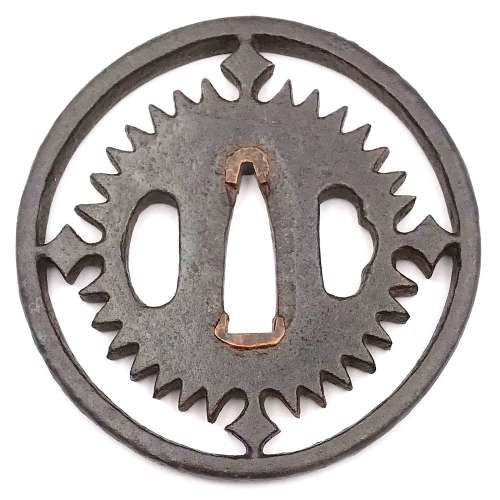 Iron tsuba of round form with design of slanting rays of light (shakoh) or clock gear (tokei) in openwork (sukashi). Commonly considered a Christian / Jesuit motif. Round-cornered rim. Copper sekigane. Momoyama period: Late 16th century (Tensho/Keicho era). Height: 72.5 mm, Width: 72.2 mm, Rim thickness: 5.5 mm, Center thickness: 5.3 mm. Round-cornered rim. Provenance: Sasano collection. Sasano Masayuki, Japanese Sword Guards Masterpieces from The Sasano Collection, Part I, № 136: "The general belief that this design represents the gear of a clock is erroneous, rather it shows the slanting rays of light from a cross, with the small diamond shapes representing the upright and transverse bars. The Christian influence is obvious..."
Iron tsuba of round form with design of slanting rays of light (shakoh) or clock gear (tokei) in openwork (sukashi). Commonly considered a Christian / Jesuit motif. Round-cornered rim. Copper sekigane. Momoyama period: Late 16th century (Tensho/Keicho era). Height: 72.5 mm, Width: 72.2 mm, Rim thickness: 5.5 mm, Center thickness: 5.3 mm. Round-cornered rim. Provenance: Sasano collection. Sasano Masayuki, Japanese Sword Guards Masterpieces from The Sasano Collection, Part I, № 136: "The general belief that this design represents the gear of a clock is erroneous, rather it shows the slanting rays of light from a cross, with the small diamond shapes representing the upright and transverse bars. The Christian influence is obvious..." -
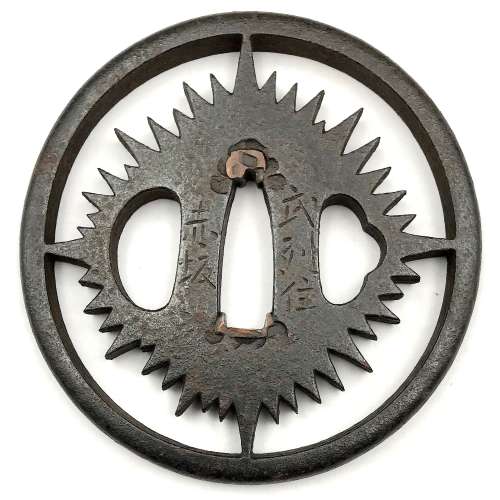 Iron tsuba of round form with slanting rays of light (shakoh) Christian motif (Jesuit’s IHS symbol) in openwork (sukashi). Traditional description of this kind of design is called “tokei”, or “clock gear”. Signed: On the face: Bushu ju Akasaka; On the back: Tadatoki Saku [Made by Tadatoki, resident of Bushu]. Probably, 4th generation of Akasaka School master Tadatoki (忠時), who died in 1746. Akasaka School. Edo period, first half of the 18th century. Size: 79.8 x 78.5 x 6.5 mm
Iron tsuba of round form with slanting rays of light (shakoh) Christian motif (Jesuit’s IHS symbol) in openwork (sukashi). Traditional description of this kind of design is called “tokei”, or “clock gear”. Signed: On the face: Bushu ju Akasaka; On the back: Tadatoki Saku [Made by Tadatoki, resident of Bushu]. Probably, 4th generation of Akasaka School master Tadatoki (忠時), who died in 1746. Akasaka School. Edo period, first half of the 18th century. Size: 79.8 x 78.5 x 6.5 mm


